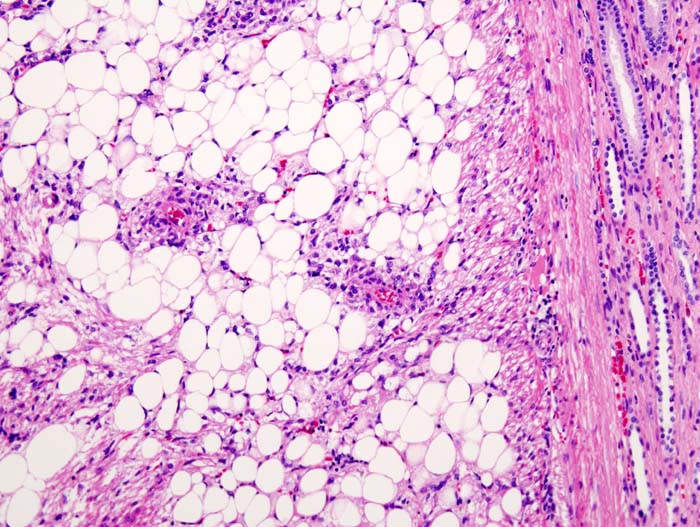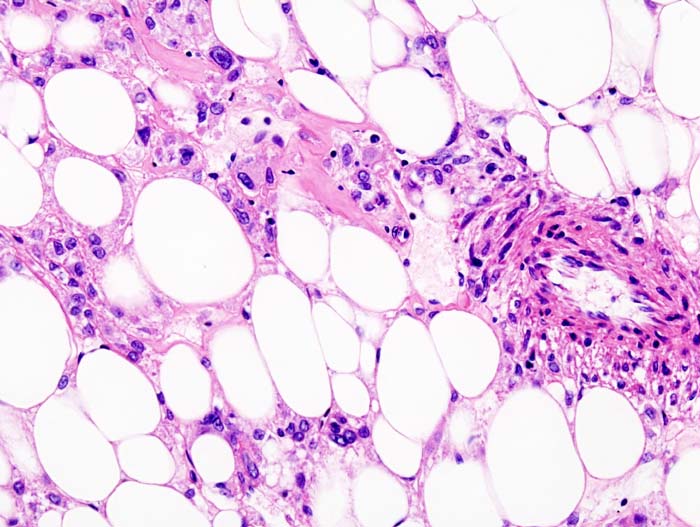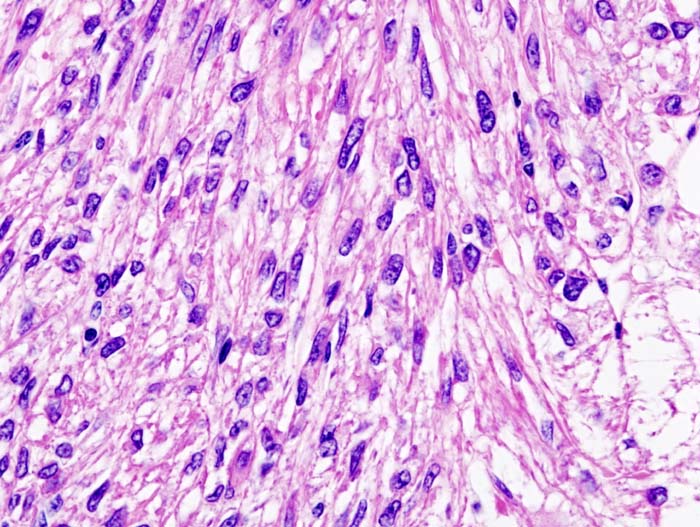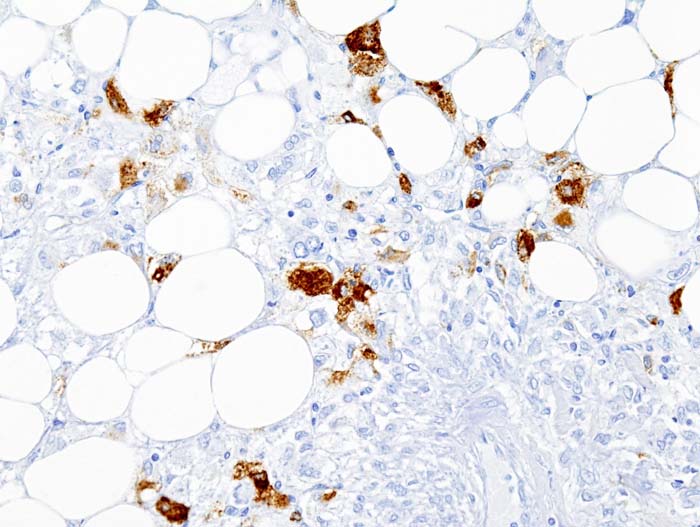Angiomyolipoma pathophysiology: Difference between revisions
No edit summary |
No edit summary |
||
| Line 34: | Line 34: | ||
[[Image:Renal angiomyolipoma (3).jpg|200px|3. Histopathologic image of renal angiomyolipoma. Nephrectomy specimen. The same case as demonstrated in "Image 1". H & E stain.]] | [[Image:Renal angiomyolipoma (3).jpg|200px|3. Histopathologic image of renal angiomyolipoma. Nephrectomy specimen. The same case as demonstrated in "Image 1". H & E stain.]] | ||
[[Image:Renal angiomyolipoma (4) HMB-45 immunostain.JPG|200px|4. Histopathologic image of renal angiomyolipoma. Nephrectomy specimen. The same case as demonstrated in "Image 1". HMB-45 immunostain.]] | [[Image:Renal angiomyolipoma (4) HMB-45 immunostain.JPG|200px|4. Histopathologic image of renal angiomyolipoma. Nephrectomy specimen. The same case as demonstrated in "Image 1". HMB-45 immunostain.]] | ||
===Cytologic=== | ===Cytologic=== | ||
Features<ref name=pmid15584043>{{Cite journal | last1 = Crapanzano | first1 = JP. | title = Fine-needle aspiration of renal angiomyolipoma: cytological findings and diagnostic pitfalls in a series of five cases. | journal = Diagn Cytopathol | volume = 32 | issue = 1 | pages = 53-7 | month = Jan | year = 2005 | doi = 10.1002/dc.20179 | PMID = 15584043 }}</ref> | Features<ref name=pmid15584043>{{Cite journal | last1 = Crapanzano | first1 = JP. | title = Fine-needle aspiration of renal angiomyolipoma: cytological findings and diagnostic pitfalls in a series of five cases. | journal = Diagn Cytopathol | volume = 32 | issue = 1 | pages = 53-7 | month = Jan | year = 2005 | doi = 10.1002/dc.20179 | PMID = 15584043 }}</ref> | ||
Revision as of 17:32, 22 September 2015
|
Angiomyolipoma Microchapters |
|
Diagnosis |
|---|
|
Treatment |
|
Case Studies |
|
Angiomyolipoma pathophysiology On the Web |
|
American Roentgen Ray Society Images of Angiomyolipoma pathophysiology |
|
Risk calculators and risk factors for Angiomyolipoma pathophysiology |
Editor-In-Chief: C. Michael Gibson, M.S., M.D. [1] Associate Editor-In-Chief: Cafer Zorkun, M.D., Ph.D. [2], Faizan Sheraz, M.D. [3]
Overview
Pathophysiology
- May be associated with tuberous sclerosis -- 70% have an AML.
- When compared to sporadic cases:
- More often bilateral.
- Usually bigger.
- Reported to often have estrogen and progesterone receptors - in the context of lymphangioleiomyomatosis.[1]
- When compared to sporadic cases:
- There is a suggestion that an epithelioid variant is more worrisome.[2]
- This is not confirmed by all studies.[3]
- More common in women than men - both in sporadic AMLs and those associated with tuberous sclerosis.[4]
Gross
- Well circumscribed - uniform yellow.
Since all three components of an angiomyolipoma (vascular cells, immature smooth muscle cells and fat cells) contain a "second hit" mutation, they are believed to have derived from a common progenitor cell that suffered the common second hit mutation. Angiomyolipomas are members of the perivascular epithelioid cells tumour group (PEComas) and are composed of variable amounts of three components;blood vessels (-angio), plump spindle cells (-myo) and adipose tissue (-lipo). Almost all classic angiomyolipomas are benign but they do have the risk of rupture with bleeding or secondary damage/destruction of surrounding structures as they grow.
Variants
There is a special variant called an epithelioid angiomyolipoma, composed of more plump, epithelial looking cells, often with nuclear atypia, that have a described risk of malignant behaviour. This variant, unlike conventional AMLs, may mimic renal cell carcinoma.10 Metastases have also been described 9.
Microscopic Pathology
Microscopic
Features:
- Smooth muscle.
- Adipose tissue - not always present[5] - key feature.
- Abundant blood vessels.
Cytologic
Features[5]
- Nuclei - round/ovoid.
- Chromatin - bland.==IHC==
- Melanocytic markers +ve.[6]
- HMB-45 +ve in all cases (15/15).[7]
- Melan A +ve in ~87% of cases (13/15).
- Epithelial markers -ve[6], e.g. EMA and AE1/AE3.
- SMA +ve.
- CD117 +ve/-ve.
- Ki-67:[8]
- Epithelioid variant of AML +ve.
- Conventional AML -ve.
References
- ↑ Logginidou, H.; Ao, X.; Russo, I.; Henske, EP. (2000). "Frequent estrogen and progesterone receptor immunoreactivity in renal angiomyolipomas from women with pulmonary lymphangioleiomyomatosis". Chest. 117 (1): 25–30. PMID 10631194. Unknown parameter
|month=ignored (help) - ↑ Nelson, CP.; Sanda, MG. (2002). "Contemporary diagnosis and management of renal angiomyolipoma". J Urol. 168 (4 Pt 1): 1315–25. doi:10.1097/01.ju.0000028200.86216.b2. PMID 12352384. Unknown parameter
|month=ignored (help) - ↑ Aydin, H.; Magi-Galluzzi, C.; Lane, BR.; Sercia, L.; Lopez, JI.; Rini, BI.; Zhou, M. (2009). "Renal angiomyolipoma: clinicopathologic study of 194 cases with emphasis on the epithelioid histology and tuberous sclerosis association". Am J Surg Pathol. 33 (2): 289–97. doi:10.1097/PAS.0b013e31817ed7a6. PMID 18852677. Unknown parameter
|month=ignored (help) - ↑ Rakowski SK, Winterkorn EB, Paul E, Steele DJ, Halpern EF, Thiele EA (2006). "Renal manifestations of tuberous sclerosis complex: Incidence, prognosis, and predictive factors". Kidney Int. 70 (10): 1777–82. doi:10.1038/sj.ki.5001853. PMID 17003820. Unknown parameter
|month=ignored (help) - ↑ 5.0 5.1 Crapanzano, JP. (2005). "Fine-needle aspiration of renal angiomyolipoma: cytological findings and diagnostic pitfalls in a series of five cases". Diagn Cytopathol. 32 (1): 53–7. doi:10.1002/dc.20179. PMID 15584043. Unknown parameter
|month=ignored (help) - ↑ 6.0 6.1 Template:Ref GUP
- ↑ Esheba, Gel S.; Esheba, Nel S. (2013). "Angiomyolipoma of the kidney: clinicopathological and immunohistochemical study". J Egypt Natl Canc Inst. 25 (3): 125–34. doi:10.1016/j.jnci.2013.05.002. PMID 23932749. Unknown parameter
|month=ignored (help) - ↑ Ooi, SM.; Vivian, JB.; Cohen, RJ. (2009). "The use of the Ki-67 marker in the pathological diagnosis of the epithelioid variant of renal angiomyolipoma". Int Urol Nephrol. 41 (3): 559–65. doi:10.1007/s11255-008-9473-1. PMID 18839327.



